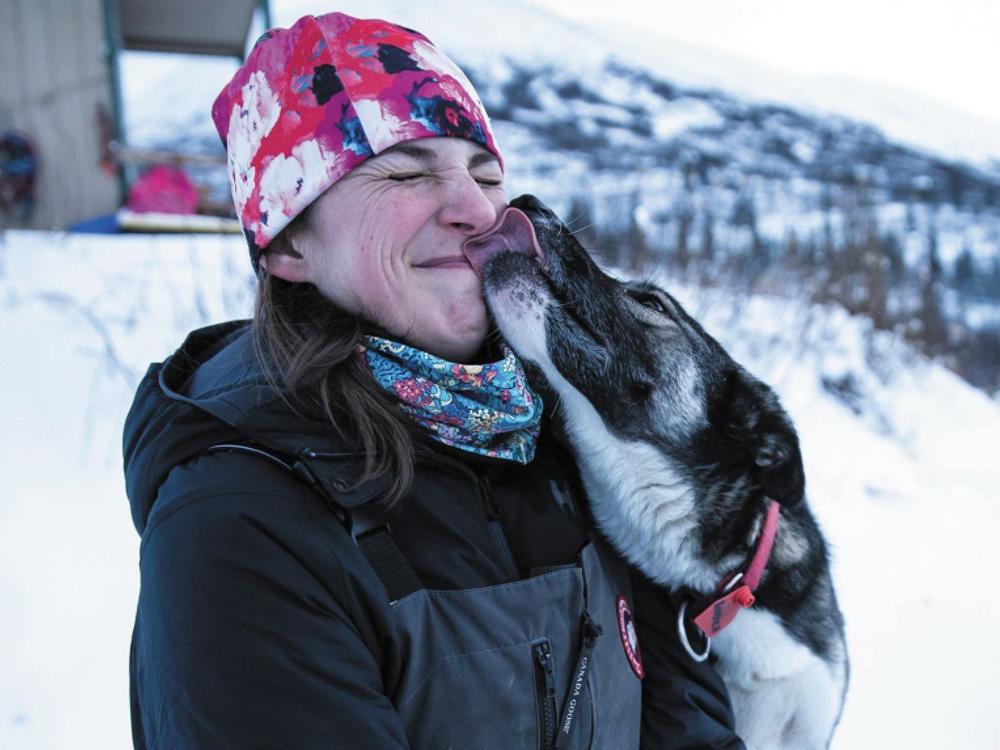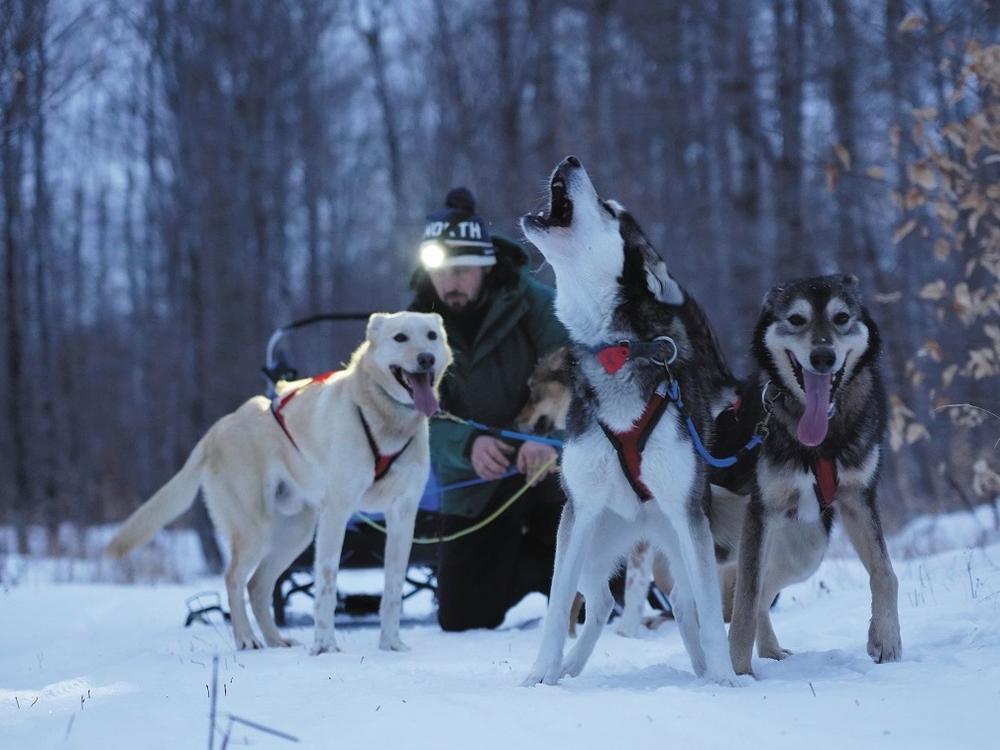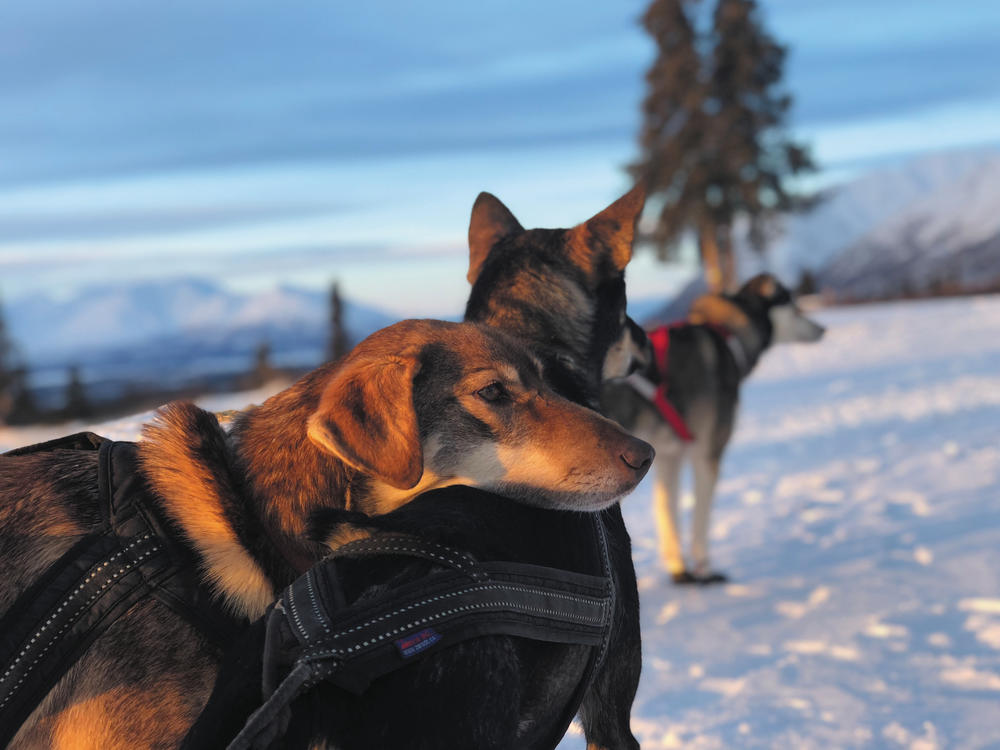Section Branding
Header Content
Don't get dragged! Iditarod musher shares tales from the trail
Primary Content
Blair Braverman, an adventurer and sled dog racer who finished Alaska's nearly 1,000-mile long Iditarod race in 2019, has some advice for aspiring mushers. Rule no. 1, she says, is to never let go of the sled or the dogs.
"People have this idea that if you let go — if you fall off the sled or if the sled tips over and you let go — the dogs will wait for you," Braverman says. "But, in fact, they will just be happier [without you], because they can run even faster, and they will keep going and you'll be left completely alone in the mountains without even your supplies that are in the sled."
Braverman says that the first time she drove a sled she tipped over seven times. She was once dragged for a quarter of a mile, bouncing along on her stomach struggling to hold until she could get the sled upright.
"You're just getting coated with snow, just snow plastered all over your face," she says. "Eventually either the dogs slow down because they get to an uphill or something or, if you have a good bond with them, they'll figure out that you're in trouble and they'll slow down to sort of let you scramble back on."
In her new book, Dogs on the Trail, which she co-wrote wither her husband and racing partner, Quince Mountain, Braverman describes a year in their dogs' lives. The book focuses less on racing than on what it takes to keep the dogs healthy, happy and working together.
"Before people have seen sled dogs in action, the question they always ask me is, 'How do you get the dogs to run?' " she says. "And as soon as they see them in action, the question switches and they start asking, 'How do you get them to stop?' "
Braverman's previous memoir is Welcome to the Goddamn Ice Cube.
Interview highlights
On how she got into dog-sledding
I grew up in Northern California, in Davis, and I had a mom who was obsessed with Alaska. She had all these Alaska books on her shelf and I would sit there and flip through them on the hottest summer days and just sort of imagine what that could be like. And so when I was 18, I moved to the Norwegian Arctic to go to a folk school, which is a yearlong non-academic boarding school where students study something that brings them joy. ... In this case, I went to a school with about 40 students in a village with about 40 people and learned dog-sledding. And it was very isolated and they push us off the deep end. We were out there spending nights alone, in 30 [degrees] below [Fahrenheit], and it was incredible. It shaped my life.
On how many dogs she has
I'll tell you a secret: You never ask a musher how many dogs they have because you're never going to get a straight answer. You will not get a number. You will get an hour-long circuitous conversation about, "Well, we have this many retirees and we have this many puppies and we're fostering a few dogs, and one of our dogs is at a friend's house and the fosters are only here for a little while." You will just get stories and not a number. And the secret is to ask a musher, "How many dogs are you feeding?" That's how you get a number.
We have 24 dogs at home right now. They are a lot of work and a lot of love. We spend an incredible amount of our time in our lives just working with the dogs and taking care of the dogs. And it's a great pleasure and a great deal of effort. For instance, for feeding, we just got a bunch of bear fat from the taxidermist here in town and we have been slicing it up on a bandsaw to make little chunks that we're going to feed them all winter when they want a little fat or a snack. They eat kibble. They eat butter. They eat fish. They eat a lot of wild meat.
On Alaskan huskies, the breed of athletic dogs that do sled racing
Most people imagine huskies and they're picturing Siberian huskies who are sort of beautiful and very fluffy, and they all have the gorgeous masks. And most mushers these days actually work with a kind of husky called an Alaskan husky. And what that is is sort of a very fast, very enthusiastic mutt who does well in cold temperatures.
One way you could think about that is a long time ago, way up north, people started breeding the prettiest dogs to the prettiest dogs, and those became Siberian huskies. And other people were breeding the fastest and the most athletic dogs, and those became Alaskan huskies. So they have a similar heritage, but they've branched apart a bit. And so Alaskan huskies are interesting, because they have never been bred to a standard of appearance. They have only been bred to a standard of health and athleticism. And so they come in every color they come in beautiful patterns and their ears can be upright or floppy, and they have curly tails or they have straight tails. Some of our dogs are yellow and some of them look like black labs to people. And some of them people think are German shepherds but they're all actually the same kind of dog — and what that is is a very highly efficient ultra runner, basically.
People think that sled dogs have to be big and strong because they think of the sport as pulling, but it's really more like running. When people have measured how much weight a sled dog is pulling in the kind of events we do in the kind of training we do, each dog is actually only pulling about five pounds at a time, once a sled gets moving, so what they are is ultra marathoners and they're quite small and they're quite lean. If you picture what a human ultramarathon looks like and then just sort of translate that into dog form.
On the role of the lead dog, which runs at the very front of the dog team
People think that the lead dog is the "alpha," like a really bossy dog, and the lead dog may be bossy, but typically what you're looking for in a lead dog is a dog whose loves the open trail. They're very independent. They love seeing a trail and running down it and making those decisions for themselves about where they're going to go. And they're really in close connection with you, the musher. ...
The way I imagine it is if you picture kindergarteners going for a walk and there's a teacher on either side and all the kids are holding hands in a line and the teacher on either side keeps them from running out into the road or doing anything completely ridiculous, my lead dog, Pepe, and I are those teachers on either end of the line when we're mushing. She and I are in cahoots to keep all the other chaotic, energetic dogs sort of going in the right direction or going in the same direction, not chasing squirrels, things like that.
She very rarely disagrees with me, but when she does, she's correct. What she's very, very good at is finding trails when they're buried in snow and when we're in storms or are in tough conditions, she actually thrives on that kind of challenge, because she loves to use her brain and she will zigzag across the trail and she's using her paws and her nose to figure out exactly where we should go. And in conditions like that, I am not going to question her at all.
On why mid-distance (200-400 mi.) races are relaxing compared to a 200-mi. adventure on her own
If I want to go on a 200-mi. adventure with my dogs, which physically they're completely capable of that, and I'm just leaving from home, I need to spend so much time researching a trail. I need to figure out if I'm going to be crossing highways and how I'm going to do that safely. How am I going to get dog food to different points of the trail? What if I need a veterinarian? How will I have a veterinarian on call if a dog has an emergency?
There's all these things I'm thinking about that are so complicated. And if you sign up for a 200-mi. race, those things are all taken care of. It's just like a beautiful trail that's groomed and you get a map and the dogs are excited because they get to be around other dog teams, which they don't often get to do and they love other dogs. And there's checkpoints and your food is going to be waiting for you at the checkpoints, your kibble and your meat for you to prepare it. And there's always veterinarians there who are volunteers who just want to answer any question you could possibly have and it's incredibly safe in that way. And if you go missing in the wilderness, someone's going to notice, and it's so relaxing. It's such a relaxing way to have an adventure with your dogs. And that was the thing that wasn't clicking for me before I did it myself. I thought, "Oh, it's just about trying to win." And in fact, it's actually about having a structure to come together with the community and have an adventure.
On what happens to the dogs' energy during the Iditarod
They start off super pumped, just completely chaotic energy and enthusiasm, and they get calmer over the course of three days. You might see some fatigue and then they start actually getting stronger again. Scientists who do a lot of research on sled dogs called this "throwing a metabolic switch." Their metabolism actually switches over in some really interesting ways where they are able to repair their muscles while they're in motion. So scientists are taking blood samples trying to understand how this happens and how, for instance, we might be able to help humans achieve this kind of athletic achievement. But as a musher, you just feel it in your team's energy. You can see that they start adjusting to the trail in really interesting ways, and their fatigue actually decreases at a certain point.
On her response to criticism of the Iditarod and dog-sledding from animal-rights activists
If someone is not treating their animals humanely, there should be no space for them in this sport at all. Something I feel very, very strongly about. There is no space for that. The point of this sport is to be with dogs who are doing something they love. And if someone does not have their dogs' best interests at heart, I do not want to be in community with them. I think that racing can be an extraordinarily positive thing for the dogs, and that's the only reason that I would want to do it. And the community of mushers that I love and that I believe in and who mean so much to me and mean so much to the sport all feel those values very, very strongly.
I have seen more pet dogs whose welfare I've been worried about than sled dogs. But of course, I'm not going to say it doesn't happen, but I think it's the job of institutions within the sport to make sure that there is no space for that.
Sam Briger and Kayla Lattimore produced and edited the audio of this interview. Bridget Bentz, Molly Seavy-Nesper and Meghan Sullivan adapted it for the Web.
Copyright 2021 Fresh Air. To see more, visit Fresh Air.
Bottom Content




